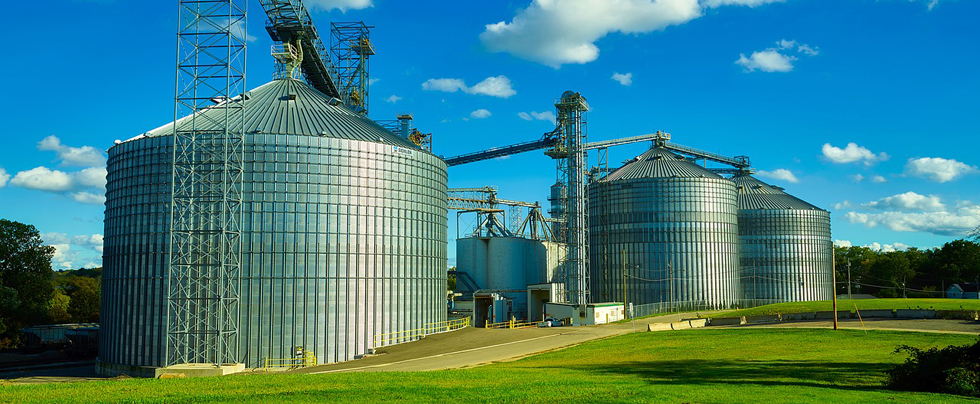Structural Pests
Powderpost Beetles
Powderpost beetle is a term used to describe several species of small (1/8-3/4 inches long), wood-boring insects that reduce wood to a fine, flour-like powder. The larvae create narrow, meandering tunnels as they feed on the wood. Infestations are discovered after noticing small, round "shotholes" in the wood surface. These are exit holes where adult beetles have chewed out of the wood after completing their development.
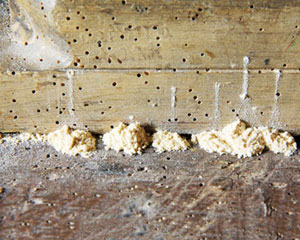
Powderpost beetle exit holes and accumulated sawdust
(Photo: townandcountrysolutions.com)
Newly-emerged adults mate and lay eggs on or below the surface of unfinished wood. Tiny larvae hatch from the eggs and bore into the wood. Life cycle from egg to adult can take from 1 to 5 years, depending on the beetle species and wood condition.
The two most common and destructive families of powderpost beetles in Kentucky are the Lyctidae and Anobiidae. Lyctid powderpost beetles only attack products manufactured from hardwoods , e.g., oak, ash, walnut and hickory. Consequently, infestations usually occur in wood paneling, molding, window and doorframes, plywood, hardwood floors, and furniture. Rafters, joists, studs and other structural framing of homes are not normally attacked by lyctid beetles because they are almost always constructed from pine or other softwoods.
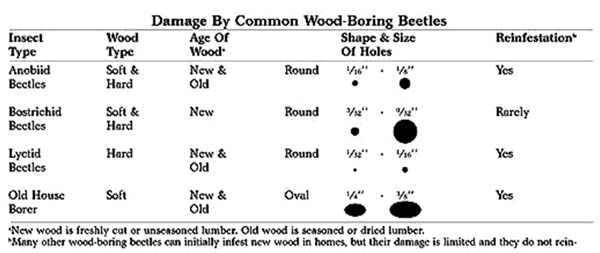
Controlling wood-boring beetles in houses (aces.edu)
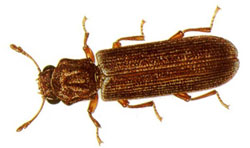 Lyctid powderpost beetle (image: epestsupply.com)
Lyctid powderpost beetle (image: epestsupply.com)
Lyctid Powderpost Beetles
Lyctids rarely infest wood older than five years. Thus, infestations generally are encountered in new homes or newly-manufactured articles. In almost all cases, infestation results from wood that contained eggs or larvae at the time it was placed in the home. Typically, the infested article was constructed from wood which was improperly dried or stored.
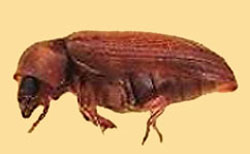 Anobiid powderpost beetle (image: epestsupply.com)
Anobiid powderpost beetle (image: epestsupply.com)
Anobiid Powderpost Beetles
Anobiid powderpost beetles may attack both hardwoods and softwoods so infestations may be found in all the same places as Lyctid beetles, as well as in structural timbers (beams, sills, joists, studs, subflooring, etc). Maple, beech, poplar and pine are especially susceptible to attack. Anobiids prefer to infest damp wood; therefore, infestations usually begin in moist, poorly-ventilated areas such as crawl spaces, basements, garages and utility sheds. Under favorable conditions of moisture and temperature, infestations may spread upwards into walls and upper levels of the structure, including furniture. Infestations may occur because of using infested lumber, or from beetles flying in from outdoors or being carried in on firewood. Infestations develop slowly, but wood can be reinfested.
Powderpost beetles sometimes die on their own accord. Therefore, it is important to be able to determine whether the infestation is active or inactive. Active infestations will usually have powder the color of fresh-cut wood sifting from the exit holes. In contrast to old, abandoned holes, new holes will not have taken on the weathered appearance of the surrounding wood. Powder streaming from recently opened holes may accumulate in small piles beneath the exit holes. If these piles of powder are covered with a film of dust or debris, the damage is old. Careful observation may be required to distinguish new powder from frass dislodged from old larval galleries by vibrations.
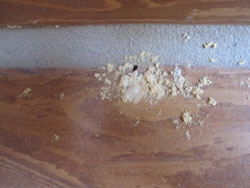
Fresh powderpost beetle activity (image: volvoab.com)
One final means of confirming that an infestation is active is to mark or seal any existing exit holes, sweep or vacuum up all powder, and check the wood later for new holes and powder. Since most ppb emergence occurs from April-July, it might be worthwhile to wait until the following spring/summer to determine if new holes and fresh powder are present (this is especially true when attempting to make a determination during the fall or winter).
[return]
Stored Grain and Product Pests
Arthropods that infest stored agricultural products can be divided into primary and secondary pests based on their feeding habits.
Primary Grain Pests
Primary pests deposit eggs on or in whole kernels and the larvae develop in them. Larval feeding destroys sound grain, reducing nutritional value, seed germination, or contaminating the product. These internal feeders also produce fines and damaged kernels that allow infestation by secondary grain pests.
Example primary pests include:
- Rice, granary and maize weevils
- Lesser grain borer
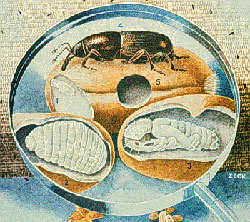 Rice weevil life stages (uky.edu)
Rice weevil life stages (uky.edu)
Grain Weevils
Weevils are among the most destructive stored product pests. Mouthparts of adults form elongated snouts characteristic of all weevils. Adults can live for four to five months.
Females typically lay 50 to 200 eggs. Females use their strong mandibles to chew small holes into grain kernels. A single egg is placed in each hole. The small, white, legless larvae hatch, feed and develop inside kernels of grain. They can survive in grains for at least 10 weeks at temperatures as low as 41°F.
Wheat, corn, oats, and sorghum are just some of their preferred foods.
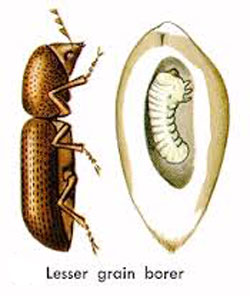 Lesser grain borer (image: Agebb.missouri.edu)
Lesser grain borer (image: Agebb.missouri.edu)
Lesser Grain Borer
The adult lesser grain borer is 1/8 inch long cylindrical beetle with a shiny dark brown or black body. The last three segments of the antennae are enlarged on one side. The body surface is rough and the head is hidden from view. Powerful jaws allow the insect to bore into wood as well as grain.
Adult lesser grain borers are strong fliers and long-lived. Females lay up to 500 eggs singly or in clusters in loose grain. Their C-shaped white larvae have dark heads and short legs. They burrow into and feed inside nearly all types of grain. Infested grain has a characteristic sweet and slightly pungent odor.
[return]
Secondary Grain Pests
Secondary pests feed on damaged or processed grains. The outer layer of the grain or
seed must be damaged, cracked, holed, abraded or broken. This may result from physical damage during harvesting, rapid drying or by the feeding of a primary feeder.
Some secondary feeders live in grain storage areas with primary feeders. Secondary beetles are collectively called "bran bugs" or "bran beetles". Concentrations of bran beetles may raise the temperature and/or moisture level within stored grain, conditions that favor rapid growth.
Two common secondary feeders of raw agricultural and processed products include the:
- Indian meal moth
- Confused and red flour beetles
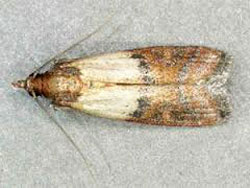
Indian meal moth adult (photo: Pest.Kill.org)
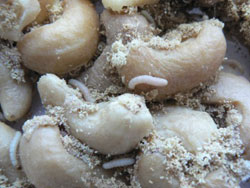
Indian meal moth larvae silk and frass (waste) in infested nuts
Indian Meal Moth
The Indian meal moth is one of the most common pests of grain storage and processing facilities and warehouses. Adults are distinctive. The outer two-thirds of the front wings are copper brown, the bases are grayish white. The hind wings are pale gray. The head and thorax are reddish brown. Adult Indian meal moths are weak fliers that are usually active for only a few hours in the evening. Usually, they remain close to the infested material.
Female adult Indian meal moths lay eggs singly or in groups directly on food material. The small, pale yellow eggs hatch in about three days. Larvae emerge and feed in the top 4" to 6" of the infested commodity. They are usually dirty white but may have a green or pink tint. Full-grown caterpillars are about 1/2 inch long with a brown head. Heavily infested materials are covered with a fine, web-like mesh of silk spun by the caterpillars. Infestations may be discovered when full-grown caterpillars crawl away from their food to spin a cocoon for pupation.
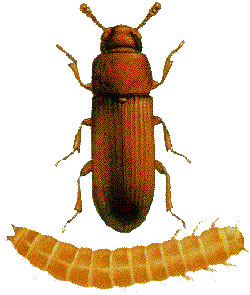 Flour beetle adult and larva (image: USDA ARS)
Flour beetle adult and larva (image: USDA ARS)
Flour Beetles
Adult confused and red flour beetles are long, flat, shiny, reddish brown insects measuring about 1/7 inch long. Female flour beetles lay several hundred small, whitish eggs directly on the food source. The female covers the eggs with a sticky secretion to which bits of the food adhere. Small, brownish white larvae hatch in five to twelve days. They are full grown in one to four months. A full-grown larva is about 3/16 inch long and tinged with yellow.
Flour beetle larvae feed on broken kernels, flour, meal and other starchy materials.
They are often hard to detect because they cover themselves with bits of the food they infest. They may appear as tiny lumps in the flour. The larvae pupate and transform into adults. Flour beetles do not penetrate whole grain kernels or undamaged grain. Instead, these secondary feeders cause damage by scraping the surface of foods or eating finely ground material. Their preferred foods include grains and grain products, peas, beans, flour, dried fruits, shelled nuts, spices and other commodities. These beetles may leave a bad odor that affects the taste of infested products.
[return]
